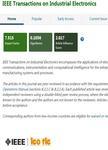版权所有:内蒙古大学图书馆 技术提供:维普资讯• 智图
内蒙古自治区呼和浩特市赛罕区大学西街235号 邮编: 010021

作者机构:Department of Electrical and Computer Engineering Auburn University Auburn AL 36849-5201 United States Control Systems Group NASA Marshall Space Flight Center Huntsville AL 35812 United States
出 版 物:《IEEE Transactions on Industrial Electronics》 (IEEE Trans Ind Electron)
年 卷 期:2004年第51卷第3期
页 面:738-739页
学科分类:0808[工学-电气工程] 0809[工学-电子科学与技术(可授工学、理学学位)] 08[工学] 0802[工学-机械工程] 0811[工学-控制科学与工程]
主 题:Control systems design methodology
摘 要:The issue separating our original paper [1] and the comments of Mantz and De Battista [2] lies in the criteria for the evaluation of an antiwindup (AW) method. Mantz and De Battista suggest that when evaluating the performance of an AW algorithm, the response of the system with AW compensation must be compared with the linear response. That is, it is claimed that the quality of an AW technique is best determined by comparing the response of a nominal proportional-integral-derivative (PID) control law in closed loop with a plant that does not have an input saturation constraint with the closed-loop response of an AWPID control law in closed loop with a plant that does have an input saturation constraint. While this criterion is valuable, it is only one of several design issues that are faced by a control system designer. Other design issues include the following: 1) closed-loop stability; 2) transient response; 3) disturbance rejection; 4) closed-loop robustness of stability and performance to modeling uncertainty; 5) required control effort; 6) controller topology (implementation concerns such as simplicity of tuning/design parameter selection).